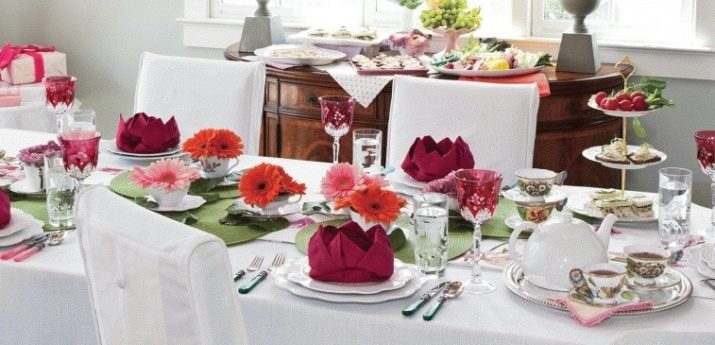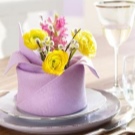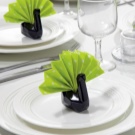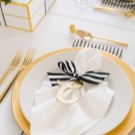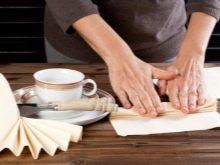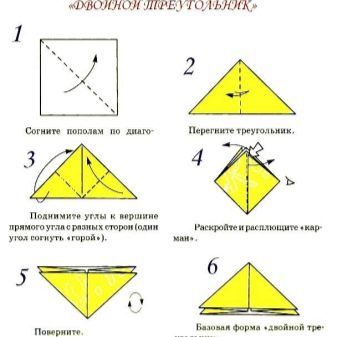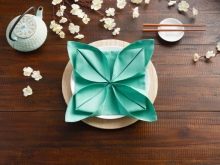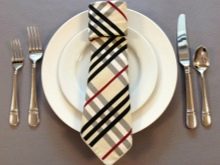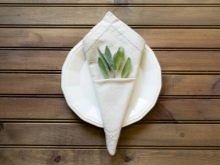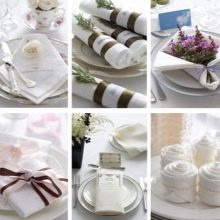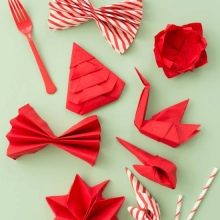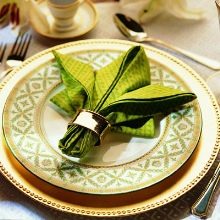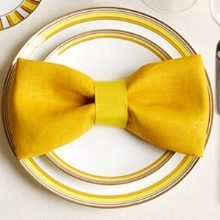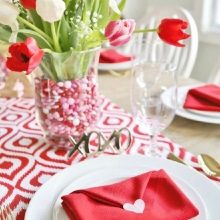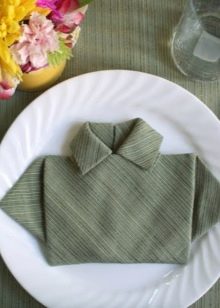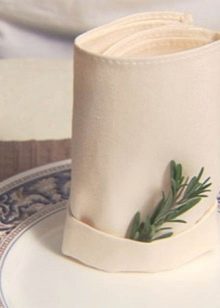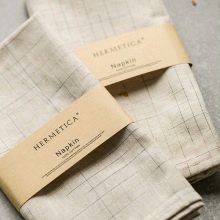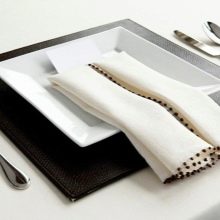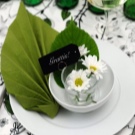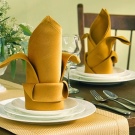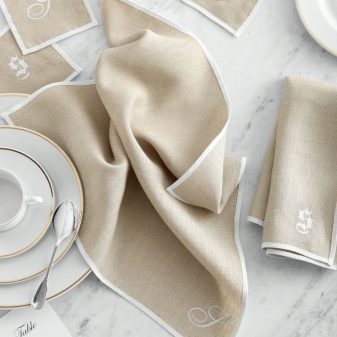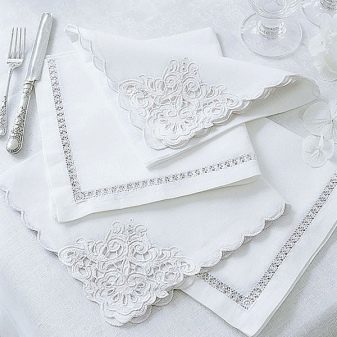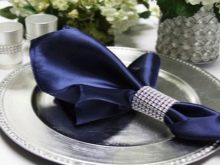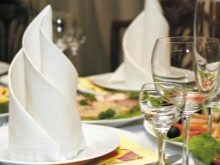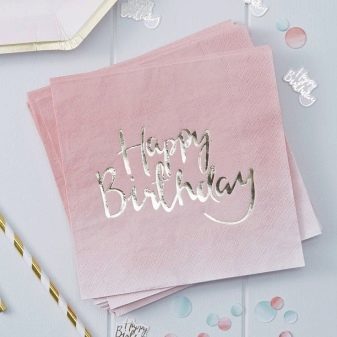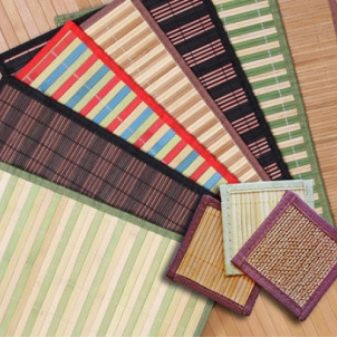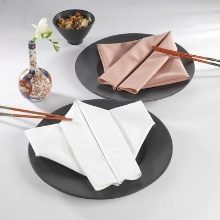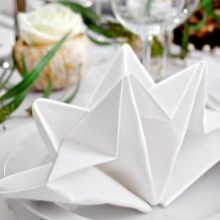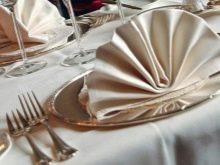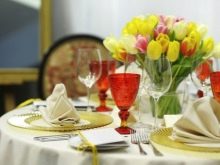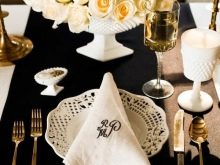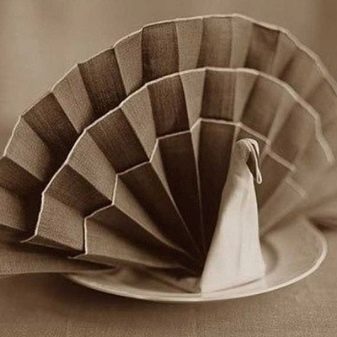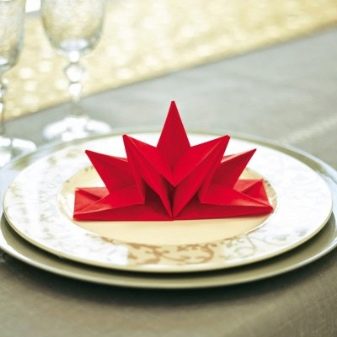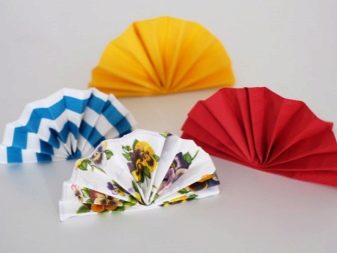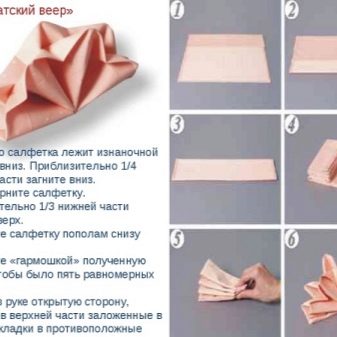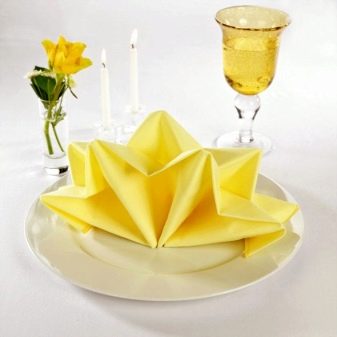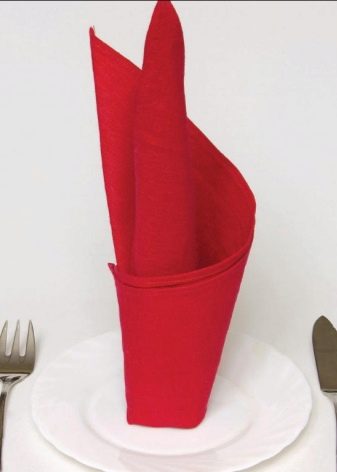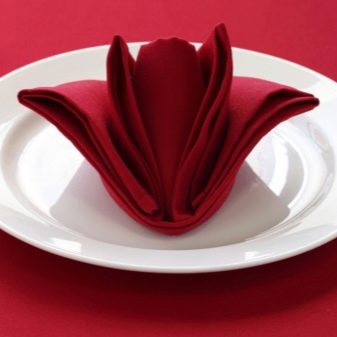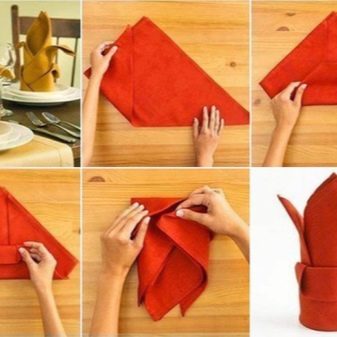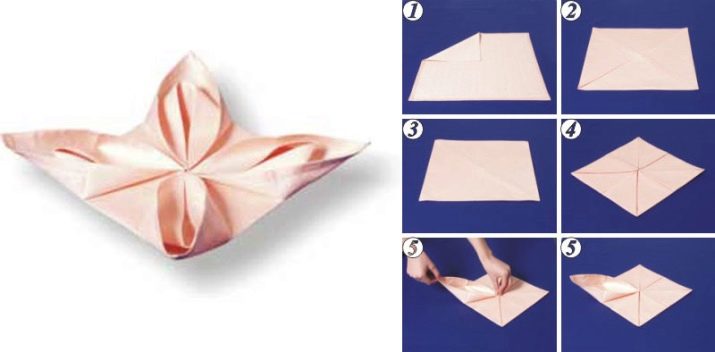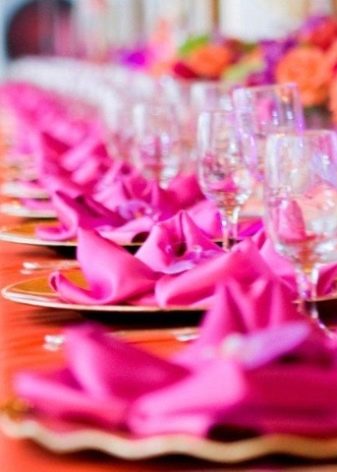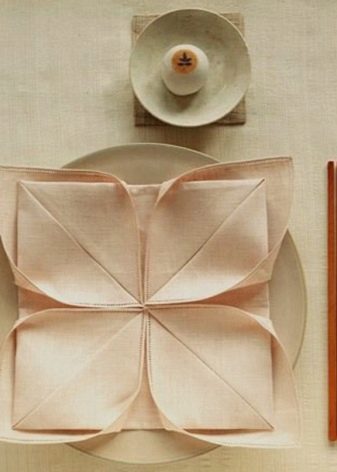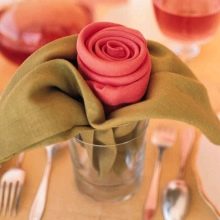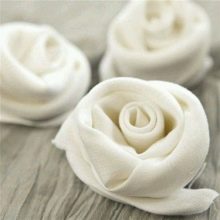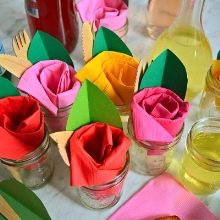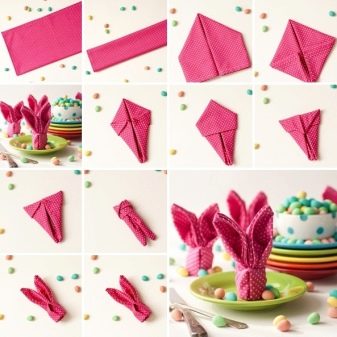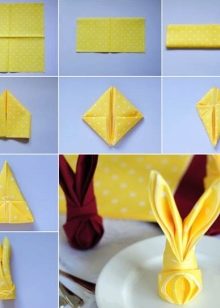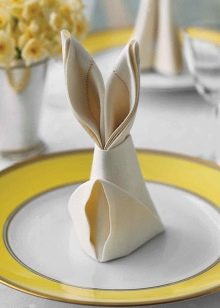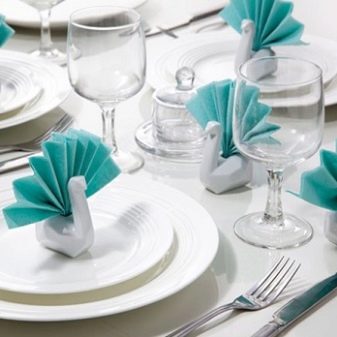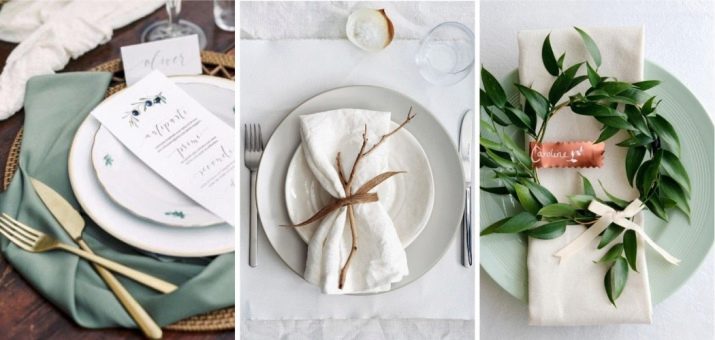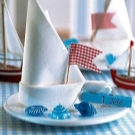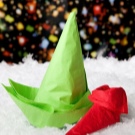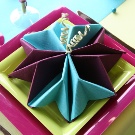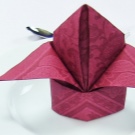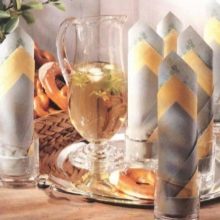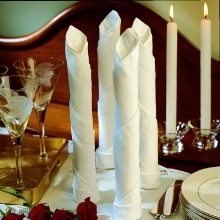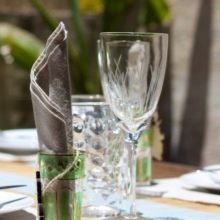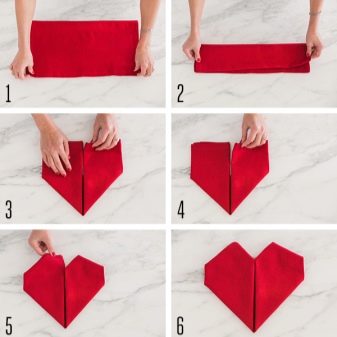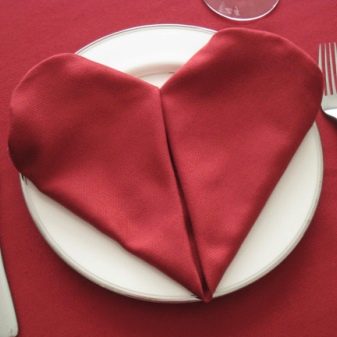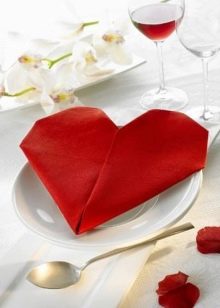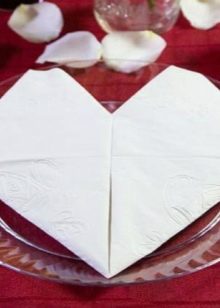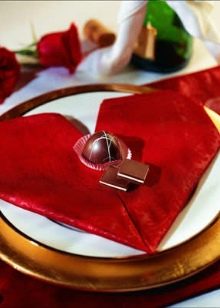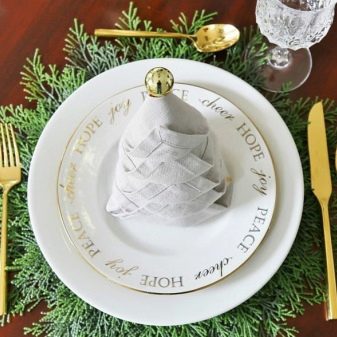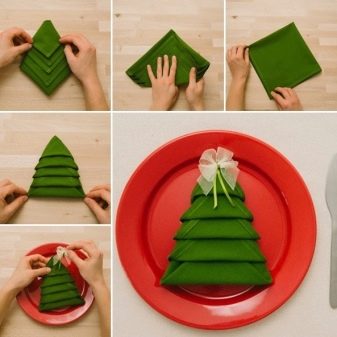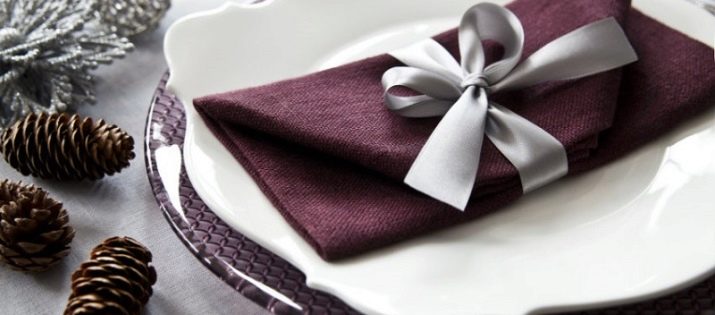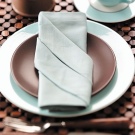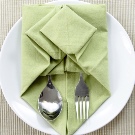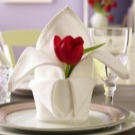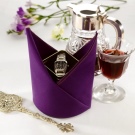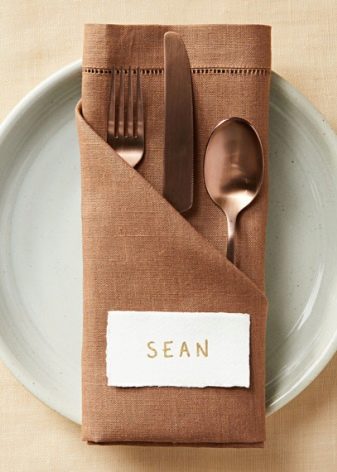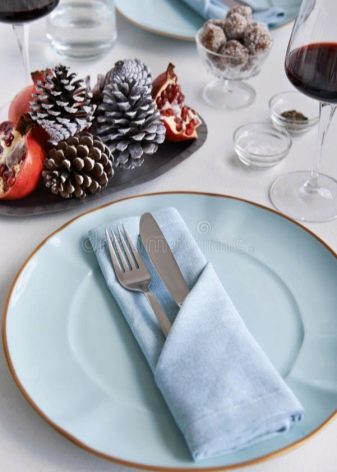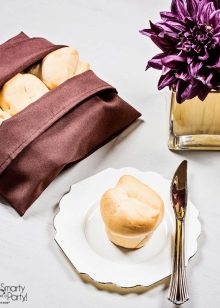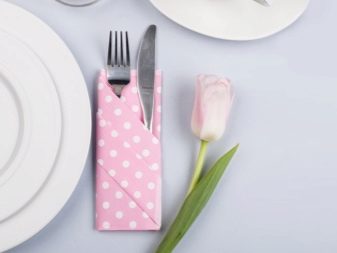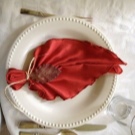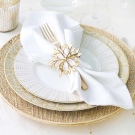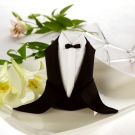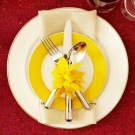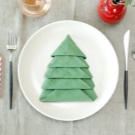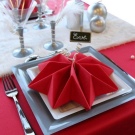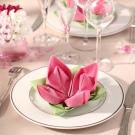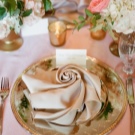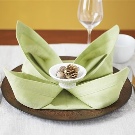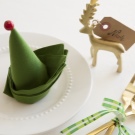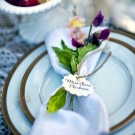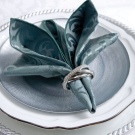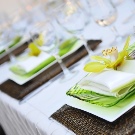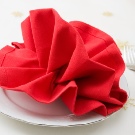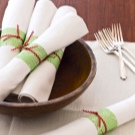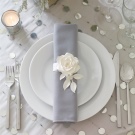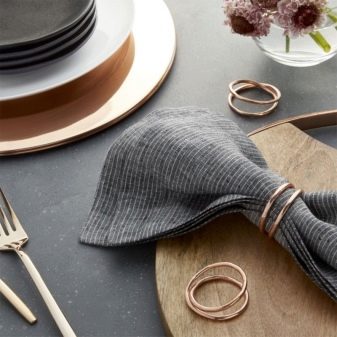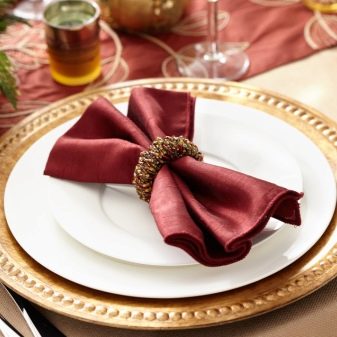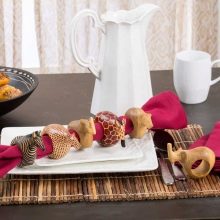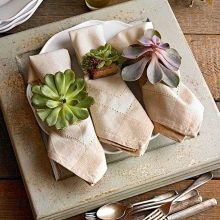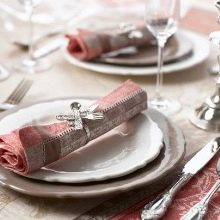How beautifully fold the serving napkins?
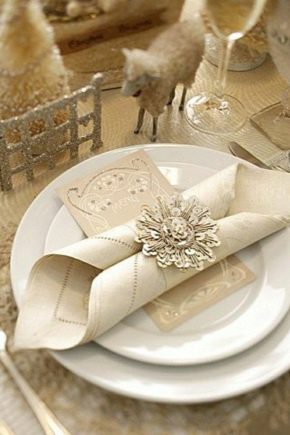
Every hostess wants the festive table to look perfect. There are many ways to make its decoration beautiful: high-quality dishes, a good tablecloth, sparkling cutlery, neat slicing of products and decorated dishes. But even before the appearance of the dish on the table, I want to dilute the boring placement of devices a la “knife to the left, fork to the right” with a small highlight. Will help in this ordinary napkins.
This is an indispensable attribute of any feast, whether it is a Christmas dinner, an anniversary or a wedding, and work great as a decorative element. Serving napkins at the same time you can take any, most importantly, correctly folded them.
We comprehend the skill: where to start?
It's no secret that the ways to give napkins an interesting shape are close to the origami technique. To beautifully fold napkins for serving the table, you need to learn some universal basic techniques. The most popular ones are:
- "Harmonic". It is needed for such simple shapes as a fan, butterfly or crane. The principle is intuitive, you just need to fold the entire napkin into an accordion with a rib width of 2-3 centimeters;
- "Book". A rectangular or square napkin folds in half. Depending on the scheme on the larger or larger side of the rectangle;
- "Doors". The square is divided visually vertically into two equal parts, both parts must be folded inwards to the fold line;
- Triangle. Two opposite corners on the diagonal are aligned with each other. Collapse on the front or seamy side, as indicated in the diagram. Paper napkins in this form can already be put in the holders;
- Double triangle. The square is visually divided into 4 parts, the two sides of the central points tuck inward, forming triangles with pockets inside;
- "Pancake". Making it is also very simple: just turn every corner to a central point. Pancake can be multi-layered. Every time when all the corners are connected at the central point, the napkin is turned over and the procedure is repeated;
- Tie. The napkin should be placed in front of you like a rhombus, outline the center line, and align the side corners in the center.
They also sometimes include a double square, a pocket, a boat or a catamaran, a frog, a bird and a fish, which themselves are not yet full-fledged figures but have common features with them. However, these forms are too complicated for a beginner and not always easy to handle.
It is better to work out the technique first on paper, then on a hard starch napkin, and only then proceed to serving textiles. But the practical choice should be preceded by the right choice of napkins.
Kinds
The correct beginning of the table design is not in the development of origami techniques with textile materials, but in the choice of napkins. Therefore, the desire to fold lilies and swallows from pieces of fabric should be postponed until later and carefully examine the issue of choosing suitable napkins.
When choosing serving napkins, several criteria are important.
The size
This is the first difference between napkins, depending on their purpose and the nature of the meal. So, for breakfast and tea parties enough napkins size 25x25, 30x30 or 35x35 centimeters. Napkins for serving to a dinner party or dinner in size 40x40cm. Sometimes there are more options, with a side of the square up to 50 cm.The most common napkins for decorating the holiday table - from 50x50 to 60x60.
The size of napkins is crucial when using them to decorate the table. The most suitable option is medium size. Too small napkins are convenient for forming figures, but there are large creases on them.like a napkin filed crumpled. Large pieces of fabric or paper are also unsuitable for complex decoration.
In the end, the napkin is needed for hygiene and etiquette, and not for the starch swans or hares to occupy half the table, no matter how beautiful they are.
The form
The classic, most common and most practical form of napkins is a square. Square napkins it is convenient to lay the table, stacking them in different ways and combining with each other. However, there are other forms, less pliable for decoration, but sometimes irreplaceable. It can be napkins, having a rectangular shape with sharp edges, elongated with rounded corners, triangular, round and oval.
As a rule, there are no papers among them. This applies to textile serving sets, which often complement the fabric tablecloth.
Colors
Color and pattern is very important. Textile napkins should be identical in tone to the color of the tablecloth. It is allowed to repeat the pattern, if any, the presence of textured details, interesting edge processing, two-sided colors. If the design idea involves two tablecloths for decorating the table at the same time, the color of napkins should correspond to the bottom tablecloth.
Only monophonic napkins are added. If they already have an active decor or thematic pattern (flowers for March 8, snowflakes for the New Year and other popular colors), it is quite nice to place them in napkin boxes. Origami in this case will already look like overkill. Moreover, with a non-monochromatic color, it is difficult to consider fold lines.
Material type
This factor is perhaps the most important. The type of material determines whether the figure from the napkin will keep its shape, whether it drapes nicely, how much it rubs, whether the serving element will withstand the washing or after the feast you have to purchase a new set. Such materials are often used in serving:
- Linen. This material is practical, natural, starchy, looks good and is well washed. It is very convenient to use it in order to fold napkins in non-trivial ways. Knocks on the fabric remains a bit. Linen napkins have a pleasant base color, so they are universal in all respects.
- Cotton. Different varieties of cotton are also distinguished by positive qualities. They are not capricious in care, they are easy to manipulate when decorating, well absorb sauces and fat, and are suitable for multiple use. Linen and cotton napkins can be combined with each other to create a beautiful decor on the holiday table.
- Silk. Rarely used due to the high cost and impracticality of the material. However, if the tablecloth is silk, napkins of the same material are necessary. They are poorly draped, the figures of a smooth material with a silky surface "crawl away", so it requires either a lot of starch, or the most simple decor. For example, various sachets, a fan lying, triangles.
- Synthetics. For decoration, it is considered the most suitable option, but the material itself is unpleasant to the touch, poorly absorbs sauces or fat, and may lose color after washing. These wipes are suitable for single use. It is desirable as an alternative to have paper on hand.
- Blended fabrics. The most practical option for the price. In addition, blended fabrics are well draped and keep their shape, have absorbent properties, wash off from different spots.
- Paper. They are not taken to fold into complex shapes. Paper napkins are needed for quick use.The most practical way is to place them in napkin holders on the table or in the access zone. Modern assortment allows you to pick them up in tone with textiles, made of thick or thin paper, with or without texture or texture.
- Parchment, PVC and bamboo. All three types are designed to protect fabric tablecloths, as well as they serve as a stand for plates and appliances, and, as it were, limit the sitting at the table to the limits of their size. This is very important for situations where a large number of guests gather at the festive table. Folding such napkins will not work. Maximum - roll into a beautiful roll. But their practicality is very great - such attributes are easy to combine with decorative napkins.
For example, the bamboo rigid napkin under the plates looks beautiful in combination with the figures from the red napkins. In this there is harmony, brevity and beauty of oriental style.
Practicality
We must not forget that the decorative function of napkins is not paramount. They are needed on the table for hygiene and guest convenience. If you really want to amaze everyone with skill, then in addition to compound tissue lotuses and ships, there should be ordinary paper napkins on the table, which can be conveniently wetted with your mouth or fingers if necessary. The same applies to the starch cloth napkins. Of course, they hold their shape better, but it will simply be impossible to use these standing napkins for their intended purpose.
Ways: walkthrough and charts
Options, how to fold napkins, weight. Among them are universal geometric shapes (triangles, envelopes, double squares, sachets and others), romantic flowers, thematic figurines (Christmas trees for the New Year's table, rings for a wedding celebration, Christmas snowflakes, ties, handbags), animals (for a children's holiday or character of the year), non-trivial forms.
Master the technique from simple shapes to more complex ones.
Fan folding
Fan is a classic table decoration. There are several variations of it. The first involves the use of auxiliary materials, in addition to wipes: soft cardboard and beautiful tape or tape.
To get a fan with a holder, you need to put a square napkin in front of you like a rhombus, so that the corners are on the vertical line. Rhombus fold in half, iron the place of the fold with your fingers, leaving a noticeable line, and expand. Then from the center line with a step of 2-2.5 cm, fold the resulting triangles into an accordion. The resulting fan is inserted into the cardboard holder.
The holder is prepared as follows: an oval 3-5 cm wide and 6-10 cm long is cut out of soft cardboard (velvet paper can be used). The length and width depend on the fan pomp. At a distance of 1 cm from each rounded edge of the oval punch holes are made. A ribbon, braid or cord is inserted into the holes. A fan made of a napkin is placed in the resulting holder, the cord is tightened and tied with a beautiful bow or knot. You can decorate the holder with inscriptions to the celebration.
The second common option is a standing fan. It is called "Peacock Tail".
The napkin needs to be spread out on a flat surface face down, folded in half into a “book”. Expand the narrow side to the edge of the table and start to form folds from it. Not the entire length, only to the middle of the napkin. The ideal fold width is the thickness of the index finger.
When the assembly is completed, holding all the folds one on another, you need to bend the napkin in width in half. It turns out a rectangle whose bottom assembly, and the top free edge. The left upper edge must be bent diagonally into a triangle and tucked between the folds.
Then the fan can be opened, and the resulting triangle will serve as a stand for it, like a photo frame.
Aesthetically looks on the table "Asian fan." The sequence of actions is as follows:
- Place the napkin face down on a flat surface.
- Bend the top edge inward one fourth of the width of the napkin.
- Turn on the front side.
- Bend inward the bottom edge of one-third the width of an already rectangular shape.
- The resulting rectangle folded in half along a horizontal line.
- From a strip of fabric, gathering it across the width of a rectangle, fold an accordion from 5 identical folds.
- Hold the lower edge of the "accordion" with your hand, and in the upper edge, straighten the outward-extending edges.
- Dissolve the fan. If the napkin is starched and tough enough, it will press the supporting part of the figure with its weight. If not, then the folds need to be fixed with a clip, then the napkin will acquire an exclusively decorative function.
Flower
A very popular “floristic” theme is in folding napkins. Flowers look beautiful, do not require special skill for performance, are relevant in almost any celebration.
Concise and elegant option - calla. This simple flower is performed step by step:
- Fold the square shape into the basic triangle shape, put the triangle with a single angle up.
- Take the upper corner of the triangle by the edge and wrap the entire napkin in a narrow bag with a diameter of not more than 1 cm.
- Turn out the wide part of the bag so that its narrowest part is inside the opened flower bowl.
- Put the resulting flower on a plate.
Another simple version that is very popular for March 8 is the tulip.
It is done as follows:
- Fold the napkin into the basic “triangle” shape and turn it upside down with the base.
- Bend the top of the triangle to the center point of the base from the bottom up. It looks like a simple sketchy boat.
- The left and right edges of the “boat” are folded down, overlapping each other a little, so that the tongue of the apex of the triangle peeks in the middle between them. Now the figure looks like two areosceles triangles superimposed on each other, the peaks of which look in opposite directions to the right and left. The horizontal line between them (can be noted visually, you can lay a pencil) - this is the fold line. On it, the lower angle, first of the upper, then of the lower triangle, is bent upward.
- The tulip is already visible, it remains only to tuck the protruding left and right corner behind the “back” of the figure and fill one end to the other so that the flower does not turn around.
Lily is a little more complicated. The first step is the same as when forming a calla - the square must be folded in a triangle and put in front of you. The left corner is point A, the upper one is B, the right one is C. The edges of the napkin should be turned inwards so that the tops of the angles A and C coincide with the top of the corner B. The diamond has to turn out. It should be folded in half horizontally, bend to the bottom edge of the top of the upper triangle. It remains only to put a napkin on a table or a plate and bend the side “petals”.
There is also a complicated version of the lily - royal. It requires wipes that keep their shape well, otherwise the petals will not be visible. Actions are performed sequentially:
- Fold a square napkin into the base “pancake” shape (repeat twice).
- Press the second layer of the "pancake" to the bottom of the glass (the corners connected in the center).
- To turn the bottom edge of each square out, it should form a petal.
- Holding the glass a little, so that the napkin takes shape, put it away and put the lily on the dish.
Similar to the royal lily, but more original is the Artichoke. To get this shape, a square napkin needs to be bent three times by angles to the center, turning over each time after all the corners are joined at the central point.
Then, as in the case of the lily, you need to stretch the bottom of all four triangles, resulting in a result. It is desirable to hold the middle of the figure with a hand or an improvised press in the form of a glass. Pulling the lower "petals" is not necessary. They should dumb rise up.Under the flower is obtained a square substrate from a napkin. Artichoke ready.
A common and beautiful way is to fold the serving napkins with a rose.
The procedure is as follows:
- Fold a tissue napkin into the basic triangle shape.
- Starting from the base of the resulting triangle, roll it into a loose "sausage", leaving the upper edge free for 7-10 cm.
- "Sausage" from left to right, twist the snail, fill the very edge of the inside of the snail so that it does not unwind.
- Take the corners of the protruding triangle and straighten them to the side.
- The lower petals are formed, you can turn the rose and put it in its allotted place.
All the same shapes are easy to replicate from thick paper napkins.
In the form of an animal
The theme of animals becomes relevant in the run-up to Easter (chickens and rabbits) and the New Year (the symbol of the coming year in the form of a dog, horse, rooster and other animals). And the napkin in the form of a bunny, fox or raccoon will appeal to children at a children's party.
Simple and affordable figure - bunny or rabbit. For this, the first thing is to wipe the cloth twice in half on the same side to the rectangle. Then repeat a series of actions:
- Having drawn a vertical line in the middle of the rectangle, bend inward the narrow edges of the rectangle so that the upper edge of the right and left sides passes through this vertical. It should turn out to be a shape similar to a blank paper airplane with beveled upper edges.
- Left and right corners of the base of the figure bend inward to make a rhombus.
- The previous fold lines formed a flat vertical line along the center of the diamond. Focusing on it, you need to bend the left and right sides of the figure in half so that the lower left and lower right edge of the rhombus coincide with this vertical. Now the figure resembles the basic form of "tie", only it expands from the bottom up, not from top to bottom.
- "Tie" you need to flip the "back" to yourself. In the upper part of the right and left will be the two most prominent points. They form a horizontal fold line along which the upper triangular part of the “tie” needs to be bent down.
- Again, turn the figure on the front side. It should look like a triangle, turned upside down. Each corner of the base has a pocket.
- The triangle is folded inside the edges, one edge hides in the pocket of the other.
- The figure turns over from top to bottom and from the front to back. At this stage, the “muzzle” and “ears” of the hare are already visible. It remains to straighten them with your fingers and put the figure on the plate.
From paper napkins it is also possible to make a rabbit or a hare, but without giving the figure a volume. Such a napkin is not necessary to put, you can simply put on a table or dish. Flat figures are obtained faster, less crumpled, and it is easier to guess the features of an animal.
To decorate a festive table for children or families by the New Year can be done with little effort by folding the napkins according to the origami pattern with a dog, tiger, rooster, horse or other animals.
Making different shapes
In addition to universal colors and individual cases of using various animal patterns, there are a large number of figures suitable for completely different celebrations. These can be napkins in the form of candles for a New Year's table, rings for a wedding celebration, figurines of tuxedos for a bachelor party, Christmas trees, snowflakes, ties, palms, ships and much more. If you use not cloth, but paper napkins, you can take as a basis absolutely any origami pattern. Several trainings, and figures of different degrees of difficulty will be obtained in one minute.
If there is no time to train, then without any preparation it is very easy to make a candle. With its help it turns out to be beautiful to serve the table for conservative events.
You need a square napkin, folded into a basic triangle shape, or a triangular napkin.It should be folded starting from the base of the triangle. "Sausage" should turn out from nine-tenths of the triangle, and the last part - a small triangle, remains free. Now the “Sausage” is folded diagonally, not strictly in half, but so that one end slightly overtakes the other. Place the fold to wrap the remaining triangle so that the candles do not fall apart.
In this form, they can be put in a glass or napkin holder. The final touch is to slightly pull up the sharp corners of the “candles” so that they become similar in shape to the flame above the wick. From small napkins in size, it is more convenient to twist a single candle.
The actual method for Valentine's Day is to set the table for two using heart napkins.
Step by step scheme of action:
- Fold the triangle with the base at the bottom, it is good to smooth it so that the corners of the top coincide as accurately as possible.
- First, right, then left the corners of the base to connect with the top, to get a rhombus.
- The upper right edge of the diamond is visually divided in half. From the midpoint, draw a perpendicular line to the middle of the opposite side. This will be the fold line. Only the triangle bends, the diamond at the bottom remains intact.
- Along the fold line, the upper part of the triangle must be turned inward, as if hidden in a pocket. Repeat the same steps on the left side. On the background of the diamond is already visible schematic heart.
- Now you need to turn the figure "back" to yourself. It looks like a rhombus without additional lines. This diamond is horizontally bent in half.
- Again, turn the figure on the front side, and you can put the finished heart on a plate.
It is impossible not to note the figures for the most beloved winter holiday - the New Year. His symbol, of course, is a Christmas tree.
It’s right to start creating this shape from the base “book”. Then it is folded in half vertically. It turns out a rhombus, in which the lower part turns with a pocket in 4 layers. Each layer alternately bends from bottom to top. The new vertex from the top of the previous layer should recede by 1-2 cm. Then the figure turns back up, face down. The left edge is bent on the right side, right on the left, the result is a "tie", tapering to the bottom. "Tie" turns back again, face down.
The shape of the Christmas tree is already visible, it is formed by triangles, the corners of which are directed downwards. Alternately, starting from the very first, they need to bend upward. The angle of the first remains free - this is the top of the fir-tree, the rest are tucked under the previous layer.
In total there should be 4 tiers and a crown. It can be decorated with a bead, a bow, an asterisk or other thematic accessory.
Not too elaborate and complicated, but original ways to fold a napkin exist to create an envelope with one pocket or several. They are in demand for official and semi-official events. This can be all the celebrations associated with the marriage, events where people unfamiliar with each other, corporate parties and business meetings meet.
The horizontal sachet is made up of a basic “book” figure, turned horizontally into a rectangle. Open the rectangle should top.
Putting it in front of you (front side inside), you need to bend the top layer of the rectangle down one third of the width. Then bend both sides inward so that the edges meet in the middle. Turn the figure back inside and turn it over so that there is a solid pocket on the front side. Cutlery is placed in this pocket.
A sachet envelope with a guest card and cutlery is simply indispensable at mass events where most of the guests are not familiar with each other.
Actions are performed in the following sequence:
- Fold a napkin book, and then in half vertically, to get the same blank as for the Christmas tree.
- Diamond diamond blank to put in front of a free edge downwards.Alternately bend upward from the bottom all the free layers, departing from the previous vertex from 0.5 to 1.5 cm.
- Bend the lower edge of 2-3 cm and stroke with your thumb.
- Fold the edges to the center of the napkin, tucking one under the other so that the sachet does not disintegrate. The smallest can be placed lower pocket insert card with guest name, cutlery in the upper pocket or next.
Sasha envelope with a pocket for a guest card without cutlery can be compared with a bag. Step by step:
- Make a blank for Christmas trees, but place the free edge of the rhombus on top.
- Bend down the top two layers with a 1-2 cm indent.
- Turn the napkin "back" to yourself.
- The corners of the rhombus lay on each other, tucked the edge of one below the other.
- Return the napkin to its original position. The top most pocket is for a name card.
"A bag" for cutlery need to start to put on the back (interesting in this case look bilateral napkins or variants with a picture). Napkin folded base "book" so that the picture or the front side were inside. Then fold the square once more. It turns out already familiar base for Christmas trees and sachets for appliances.
A diamond base to unfold in front of him with a free edge up. Bend down from top to bottom with the indentation between the layers of the first three layers. Flip to the other side and fold the corners of a rhombus inside that the edges come together in the middle and get a "tie". Turn over to the other side again. Chicken ready, left to invest appliances.
Examples and options
You can decorate the table with napkins in different ways. However, it is important to follow a few simple rules when choosing shapes and materials:
- Wipes should be of high quality;
- The figures unfold easily for the guest;
- Plain napkins always look better than alypisty;
- Napkins may be of different colors, if the guests are seated a few tables, but the fabric and the design should be the same as the figures, which are added;
Napkin design ideas need to be coordinated with the cause of the feast. Complex shapes out of paper (snowflakes, three-dimensional flowers and animals) would be appropriate as a decoration for the home and children's celebrations. In addition to these, full napkin holders should be freely available. Textile strict sachets - attributes of business meetings and official events.
Replace the napkin a small vase or move them, for example, in a glass - is also a way to decorate the original table. Some figures (roses, candles, fans varieties) better look inside a transparent glass than on the plate, and are not guaranteed to unfold.
For large celebrations (anniversaries, weddings) provided a more expensive, but justifies its price aesthetic qualities version - napkin rings. Among them are the product of metal, wood, glass, ceramics, textiles, paper (disposable). They are executed in a very different style and organically supplement just like the air, whipped a napkin, and any shape, from the double-tube and ending with a flower.
About how beautifully folded napkins for table (6 simple ways), see the following video.
